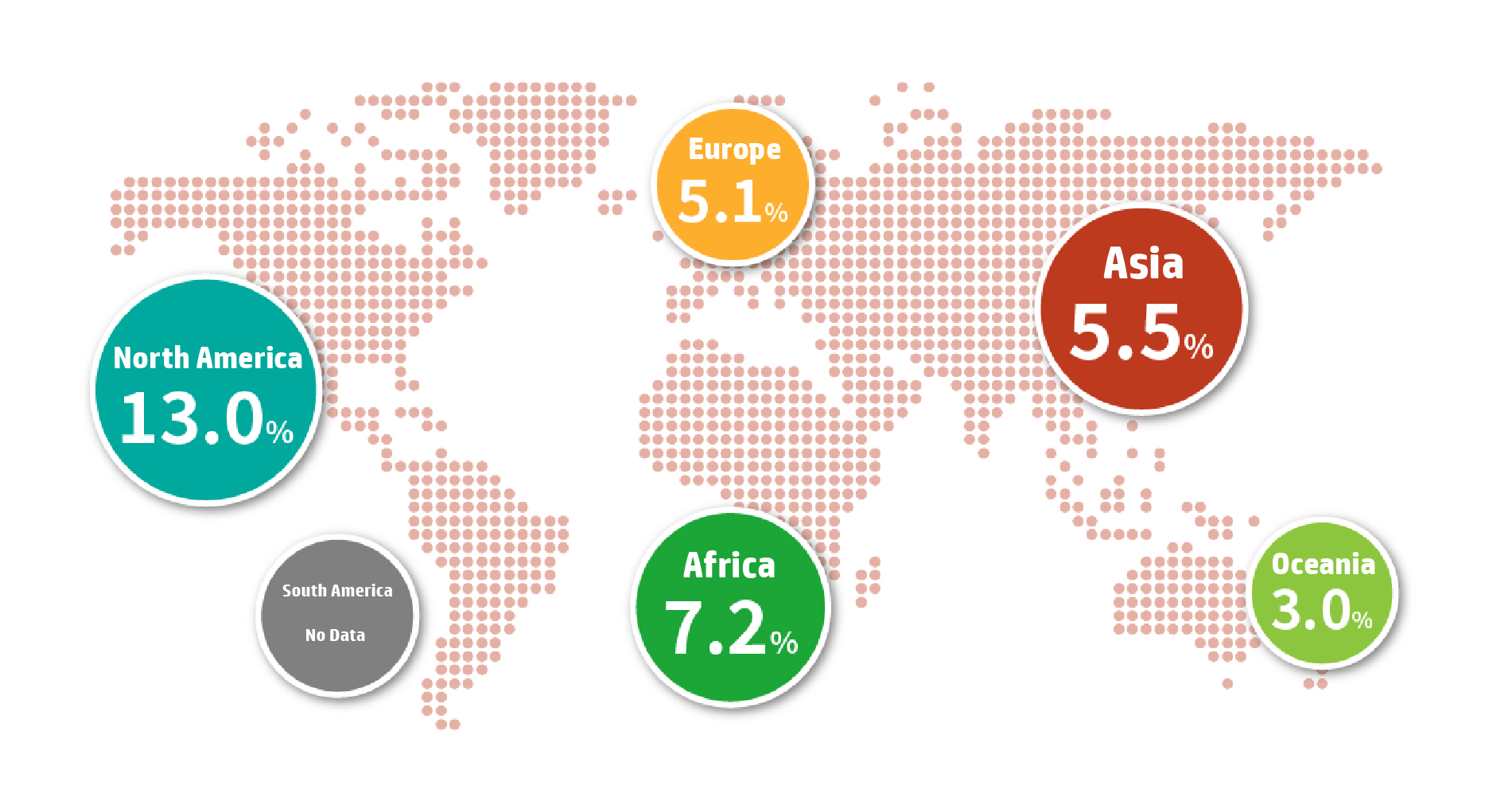Diabetic Foot Ulcers (DFU) represent a significant and escalating complication of diabetes, affecting millions worldwide. With over 800 million people living with diabetes globally, the prevalence of DFU is a pressing issue that demands urgent attention.
Global Prevalence and Impact
The International Diabetes Federation (IDF) estimates that approximately 6.3% of adults with diabetes worldwide suffer from DFU. This condition not only impacts the physical health of individuals but also places a substantial burden on healthcare systems globally.
Regional DFU Prevalence
- North America: Approximately 13.0% of adults with diabetes are affected by DFU.
- Africa: The prevalence stands at 7.2%.
- Asia: Approximately 5.5% of adults with diabetes experience DFU.
- Europe: The prevalence is around 5.1%.
- Oceania: Approximately 3.0%.
These figures highlight the widespread nature of DFU and the varying degrees of impact across different regions.

United States
In the United States, approximately 1.6 million people develop a diabetic foot ulcer each year. These ulcers precede 80% of lower extremity amputations among people diagnosed with diabetes and are associated with an increased risk of death. Neurological, vascular, and biomechanical factors contribute to diabetic foot ulceration. Approximately 50% to 60% of ulcers become infected, and about 20% of moderate to severe infections lead to lower extremity amputations. The 5-year mortality rate for individuals with a diabetic foot ulcer is approximately 30%, exceeding 70% for those with a major amputation. The mortality rate for people with diabetic foot ulcers is 231 deaths per 1000 person-years, compared with 182 deaths per 1000 person-years in people with diabetes without foot ulcers. People who are Black, Hispanic, or Native American and people with low socioeconomic status have higher rates of diabetic foot ulcer and subsequent amputation compared with White people.
Saudi Arabia
In Saudi Arabia, the prevalence of diabetes among adults aged 20-79 was 18.7% in 2021, with approximately 4.27 million adults living with diabetes. The country is projected to see a rise in diabetes cases, with estimates reaching 7.54 million by 2045. While specific data on DFU prevalence in Saudi Arabia is limited, the high diabetes prevalence suggests a significant burden of diabetic foot complications. The IDF reports that the Middle East and North Africa (MENA) region has a diabetes prevalence of 17.7% among adults.
China
China has seen a significant increase in diabetes prevalence, with 10.6% of adults aged 20-79 affected in 2021, up from 8.8% in 2011. This translates to over 130 million adults living with diabetes, making China home to the largest diabetic population globally. The rising prevalence of diabetes in China is attributed to rapid urbanization, dietary changes, and sedentary lifestyles. This trend is concerning, as it may lead to an increase in diabetic foot complications, including ulcers and amputations. While specific DFU prevalence data for China is scarce, the high diabetes rates indicate a growing public health challenge.
Brazil
In Brazil, the prevalence of diabetes among adults aged 20-79 was 8.8% in 2021, with approximately 15.7 million adults living with diabetes. The country is projected to see an increase in diabetes cases, with estimates reaching 23.8 million by 2045. The DFU prevalence in Brazil is 21% suggests a significant burden to Brazilian society, while the IDF reports that the South and Central America region has a diabetes prevalence of 10.5% among adults.
European Union
In the European Union, approximately 5.1% of adults with diabetes are affected by DFU. The IDF reports that the region has a diabetes prevalence of 9.8% among adults. The rising prevalence of diabetes in Europe is attributed to aging populations, urbanization, and lifestyle factors. This trend is concerning, as it may lead to an increase in diabetic foot complications, including ulcers and amputations.
Treatment Challenges: Recurrence Rates of Ulcers
Approximately 40% of patients experience a recurrence of DFU within one year after healing, and nearly 60% will face recurrence within three years. These high recurrence rates underscore the need for comprehensive management strategies that include regular monitoring, patient education, and multidisciplinary care to prevent re-ulceration and associated complications.
Importance of Early Detection and Care Knowledge
Beyond treatment challenges, emphasizing early detection and care knowledge is vital. Raising awareness among patients and their families about the signs of early skin damage and situations requiring prompt medical attention can lead to positive outcomes in preventing the occurrence and recurrence of ulcers. Educational initiatives should focus on proper foot care practices, the importance of glycemic control, and the need for regular medical check-ups. Community-based programs and healthcare provider training are essential to enhance the capacity for early detection and effective management of diabetic foot complications.
Reference:
- International Diabetes Federation. (2021). IDF Diabetes Atlas (10th ed.). https://diabetesatlas.org
- Armstrong, D. G., Boulton, A. J. M., & Bus, S. A. (2017). Diabetic foot ulcers and their recurrence. The New England Journal of Medicine, 376(24), 2367–2375. https://doi.org/10.1056/NEJMra1615439
- Lavery, L. A., Armstrong, D. G., Wunderlich, R. P., Mohler, M. J., Wendel, C. S., & Lipsky, B. A. (2006). Risk factors for foot infections in individuals with diabetes. Diabetes Care, 29(6), 1288–1293. https://doi.org/10.2337/dc05-2425
- Armstrong, D. G., Lavery, L. A., & Harkless, L. B. (1998). Validation of a diabetic wound classification system. Diabetes Care, 21(5), 855–859. https://doi.org/10.2337/diacare.21.5.855
- Hicks, C. W., Selvarajah, S., Mathioudakis, N., et al. (2016). Burden of infected diabetic foot ulcers on hospital admissions and costs. Annals of Vascular Surgery, 33, 149–158. https://doi.org/10.1016/j.avsg.2015.11.025
- Singh, N., Armstrong, D. G., & Lipsky, B. A. (2005). Preventing foot ulcers in patients with diabetes. JAMA, 293(2), 217–228. https://doi.org/10.1001/jama.293.2.217
- TheGlobalEconomy.com. (2021). Diabetes prevalence – China. https://www.theglobaleconomy.com/China/Diabetes_prevalence/
- International Diabetes Federation. (2021). Country profile: Brazil. https://diabetesatlas.org/data/en/country/32/br.html
- DFU.com.tw. (n.d.). About diabetic foot ulcers. Taiwan Diabetic Foot Ulcer Education Network. https://dfu.com.tw/about_detail2.php
- IntechOpen. (2024). Diabetic foot ulcer epidemiology in South America. In Current advances in the management of diabetic foot ulcer. https://www.intechopen.com/chapters/1166144
- Centers for Disease Control and Prevention. (2023). Mortality and complications of diabetic foot ulcers. PubMed Central. https://www.ncbi.nlm.nih.gov/pmc/articles/PMC9797649/

